MARIANI’S
Virtual Gourmet
JULY 19,
2015
NEWSLETTER
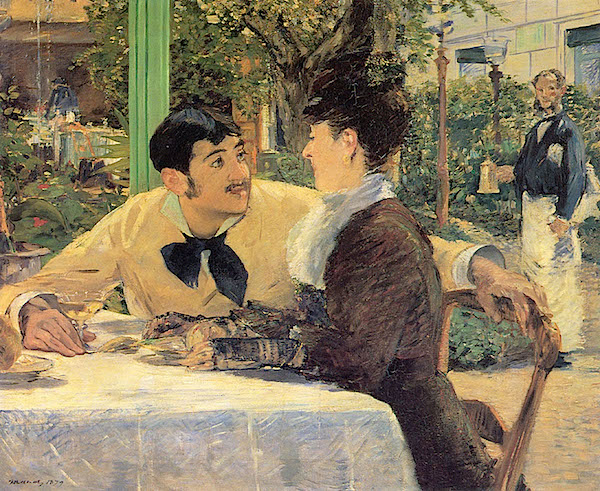
"À La Père Lathuille" by Eduoard
Manet (1879)
IN THIS ISSUE
L'ÉPICURE
WHAT A THREE-STAR
RESTAURANT IN PARIS MEANS
By John Mariani
WHAT'S OLD IS NEW AGAIN
IN PARIS HOTELS:
The Hilton Paris Opéra
by John Mariani
NEW YORK CORNER
BOTEQUIM
By John Mariani
NOTES FROM THE WINE CELLAR
GREEK WINES
By Mort Hochstein
❖❖❖
WHAT A THREE-STAR RESTAURANT
IN PARIS MEANS
By John Mariani
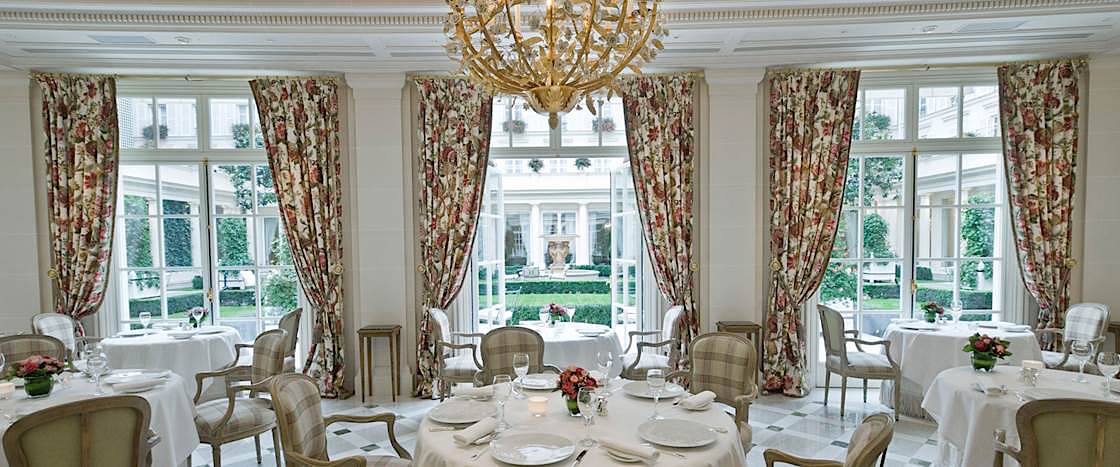
L’Épicure
It is never really out of
place to ask whether a person should spend
hundreds of dollars for a single meal at a single
restaurant.
It is certainly not a moral question, for
people easily spend as much or more on sporting
events, Broadway theater and rock concerts. The
better question is, why exactly does such
a meal cost so much?
Should the number of courses
determine the cost? Should the rent on the
restaurant? Should
the celebrity of the chef? Those do count, though I think
the extravagance of 20-plus-course meals is more
about a chef’s ego than it is about excellence and
is usually more an ordeal than a pleasure. (The odd
thing is that chefs themselves loathe it
when other chefs force-feed them dozens of dishes.)
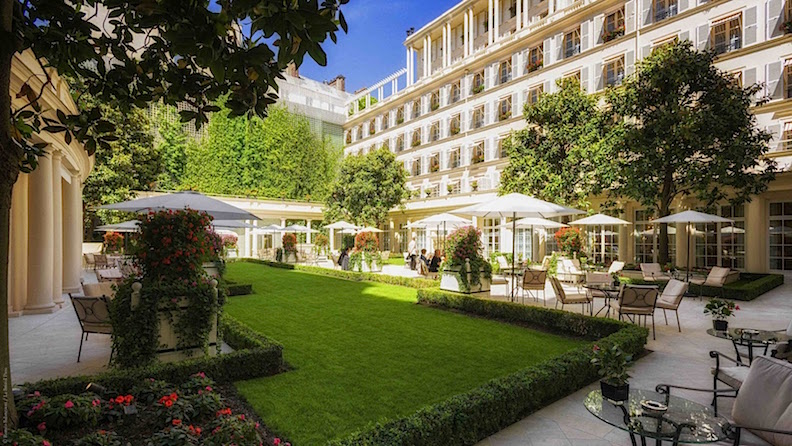 The Michelin
Guide has always been farcical in its contention
that its inspectors give out stars only for
what’s on the plate, as if they go blindfolded, but
then give three stars only to the
most expensive restaurants on the planet. And their
over-the-top explanation of what constitutes a
three-star rating--“worth a journey”--is just plain
silly, as if you are going to Lourdes to be cured of
an incurable disease.
The Michelin
Guide has always been farcical in its contention
that its inspectors give out stars only for
what’s on the plate, as if they go blindfolded, but
then give three stars only to the
most expensive restaurants on the planet. And their
over-the-top explanation of what constitutes a
three-star rating--“worth a journey”--is just plain
silly, as if you are going to Lourdes to be cured of
an incurable disease.
Still, the idea of a restaurant
garnering the highest ratings from so many quarters
gives me reason to discuss what exactly it is that
you’re getting for your money, and, just as
important, how such an experience differs from a
lesser one where you spend a lot of money for only
“what’s on the plate,” so often in a dining room
with all the color, décor and sensual appeal of a
cement bunker (think Alinea in Chicago, Catbird Seat
in Nashville, Bianca in New York).
Which brings me to the stunningly
beautiful Paris restaurant L’Épicure
at Le Bristol hotel, which is itself, recently
renovated, one of the city’s finest and most
elegant, from the reception at the front desk and
the assistance of the concierge, under the eagle
eyes of Sonia Papet, to the effusion of flowers
everywhere and, never to be forgotten, two very
spoiled cats who roam the public rooms. Along with
L’Épicure, it’s all a seamless part of a grand
design. 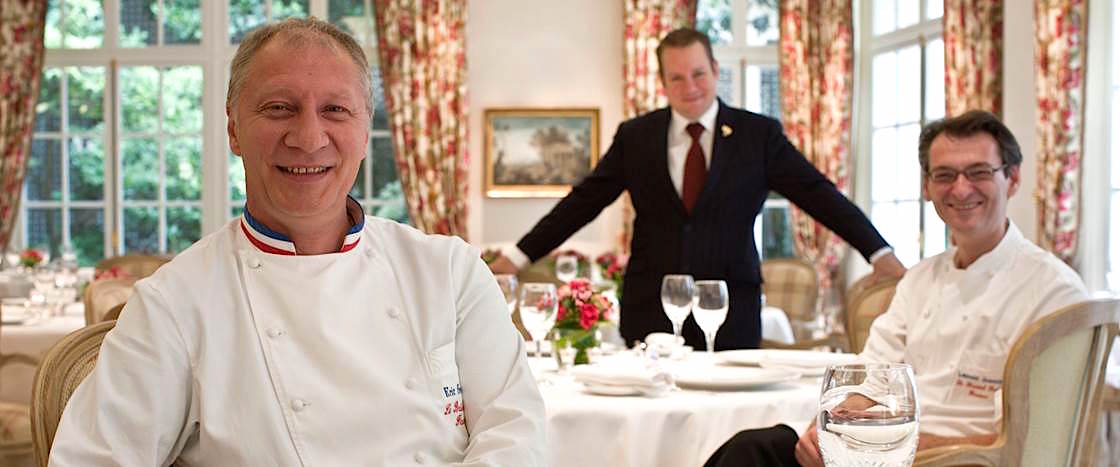
L’Épicure, which has held three
Michelin stars since 2009, has been re-located to a
very sunny room overlooking the gardens (above) and from
the moment you are greeted, you are made to feel
quite special and in for surprises. The
room’s formality is softened by the lightness of
colors, a shimmering gold chandelier, and the
country tartan-patterned chairs set at round tables
with exquisite linens, delicate china, heavy silver
flatware and thin wine glasses. A small bouquet of
flowers brightens the ambiance even more, echoed in
the garden and fountain surrounded by trim hedges
and flourishing
ivy. This
is not a hushed dining room, like some of its kind
in Paris, although in its earlier, very formal
interior setting, now used for banquets, it was. L’Épicure is now a place where a
wide variety of people are clearly having a very
good time without pomp or ceremony beyond the artful
professionalism of the crew. You can see them marvel
at the food they are eating as they bask in a cocoon
of elegant comfort.
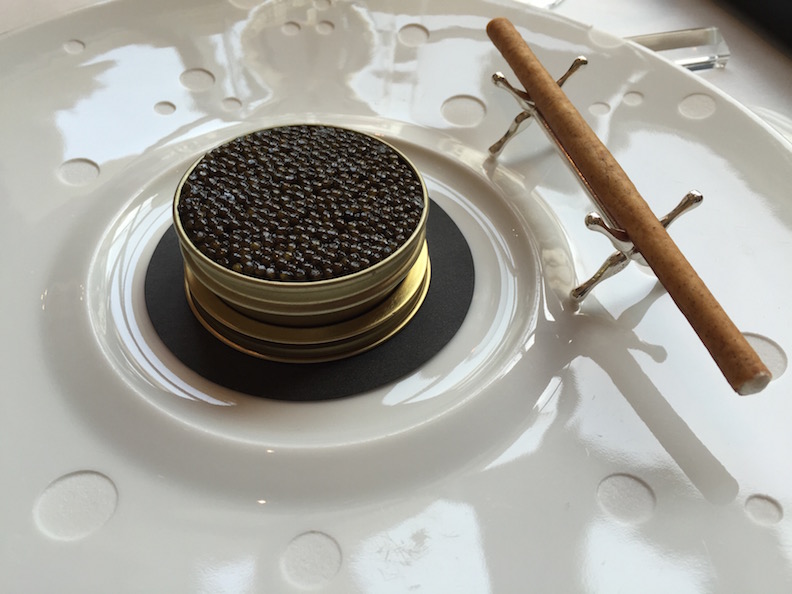 The
impeccably dressed waitstaff, from maître d’
Frédéric Kaiser to sommelier Marco Pelletier and his
six assistants (this, for a 40-seat restaurant)
maintain a remarkable balance of cordiality without
intrusion, ever attentive to a guest who merely
looks up for assistance, always refreshing wine
glasses, setting down new silverware, crumbing the
table, removing and replacing dishes.
The
impeccably dressed waitstaff, from maître d’
Frédéric Kaiser to sommelier Marco Pelletier and his
six assistants (this, for a 40-seat restaurant)
maintain a remarkable balance of cordiality without
intrusion, ever attentive to a guest who merely
looks up for assistance, always refreshing wine
glasses, setting down new silverware, crumbing the
table, removing and replacing dishes.
Aside from breakfast, L’Épicure
serves exactly 40 people twice a day, with 40 cooks
in the kitchen working under Eric Fréchon (above), surely
the least self-promoting master chef in Paris, known
more as a chef’s chef rather than as a celebrity. He, along
with chef de cuisine Franck Leroy, stays put in his
kitchen, fretting about every drop of sauce and the
temperature of every plate.
I had lunch with my son at
L’Épicure this spring and asked to have Fréchon do a
tasting menu, along with wines, which delighted the
captain who took our order. As soon
as that was done, with a glass of Champagne in hand,
we were treated to Sologne Imperial caviar (all
ingredients at L’Épicure are from France) atop ratte (fingerling)
potatoes with a mousseline of smoked haddock and
buckwheat crisp (left). Several
breads and wonderful butter, at just the right
temperature, were offered.
Next came Fréchon's signature
stuffed macaroni (Paris is infatuated with Italian
pasta these days) with black truffle, artichoke and
duck foie gras, then dusted with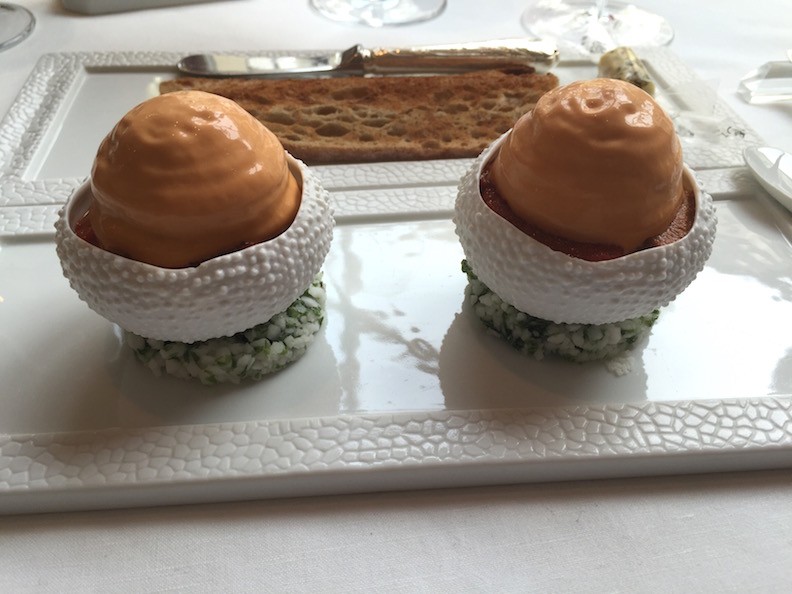 Parmigiano
and set under the broiler--just about the most
wonderful mac-and-cheese dish in the world! Purple
sea urchins were simmered in bouillon in their
shells and mixed with an egg mousse, looking like a
luscious, briny ice cream coupe (right). With
these we drank a brisk Domaine Raveneau “Butteaux”
Chablis 2009.
Parmigiano
and set under the broiler--just about the most
wonderful mac-and-cheese dish in the world! Purple
sea urchins were simmered in bouillon in their
shells and mixed with an egg mousse, looking like a
luscious, briny ice cream coupe (right). With
these we drank a brisk Domaine Raveneau “Butteaux”
Chablis 2009.
Wild turbot of unsurpassed
tenderness absorbed the flavors of wild pink garlic
and pine nuts, with simply sautéed baby spinach with
a whipped brown butter zabaglione. Domaine Des
Rémizire Croze-Hermitage “Cuvée Particulière” 2010 was
poured.
The next dish was extraordinary
in so many ways, even as something wholly amusing.
Fréchon takes a Bresse farm hen and poaches it in a
pig’s bladder (below)--a
very old technique called en vessie--and
for service it is set on a magnificent sterling
silver stand of chicken legs seemingly made for this
dish alone. The
bubble was cut open and--voilà!!--the
aroma and
steam filled the air, then the breast was cut
tableside and served with a vin jaune
sauce with giblets, meaty crayfish, spring’s
loveliest asparagus and morels, as the dark meat was
whisked away back to the kitchen to be seared and
cooked further then brought out again to be plated
with a simple herb salad. Cave des Amandiers Valais
“Petite Arvine” 2011 was perfect with this wondrous
dish.
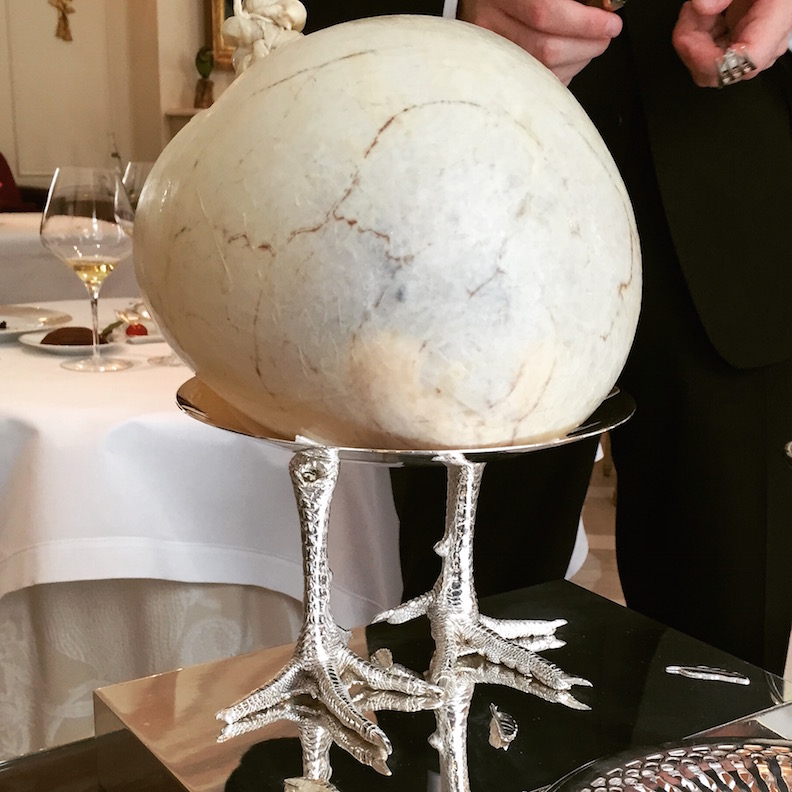 An
array of seasonal, regional French cheeses, all in
the ripest condition, came on an antique silver cart
(they have two), with Domaine J. Grivot
Nuit-Saint-Georges “Les Charmes” 2009.
An
array of seasonal, regional French cheeses, all in
the ripest condition, came on an antique silver cart
(they have two), with Domaine J. Grivot
Nuit-Saint-Georges “Les Charmes” 2009.
At a timely interval several of
pâtissier Laurent Jennine' s desserts arrived,
including “Priceless Nyangbo chocolate” with cocoa,
thin tile wafers and gilded sorbet, served with a
Galateo Coume del Mas Banyuls 2011, and lichees set
in an iced meringue and perfumed with rose, pear and
lemon, accompanied by a Trimbach Gewürztraminer VT
2007.
But we were not quite finished.
At this point they wheeled over an eye-popping
silver chest (below,
left) whose lid was opened to reveal
petits-fours and a rainbow of macarons as light as
Communion hosts and as decadent as venial sin.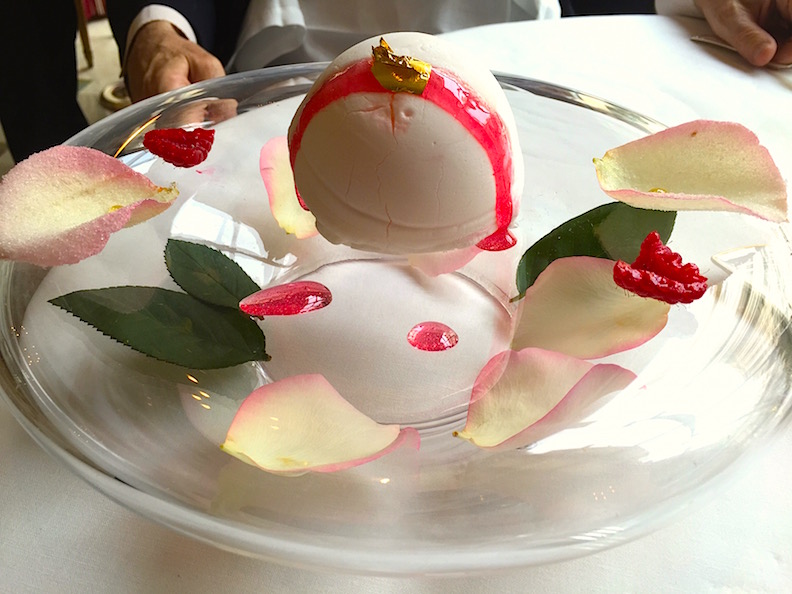
So, were I judging the meal
solely on “what’s on the plate,” there was no
question that this was one of the greatest of my
career and my life, with every single dish
conceptualized to maximize each perfect ingredient
used--and there were not many in any dish--and to
make them beautiful without burdening the plate with
anything extraneous.
Sheer showmanship was on display only with
that marvelous hen and the desserts; the rest
centered around flavors I shall long remember.
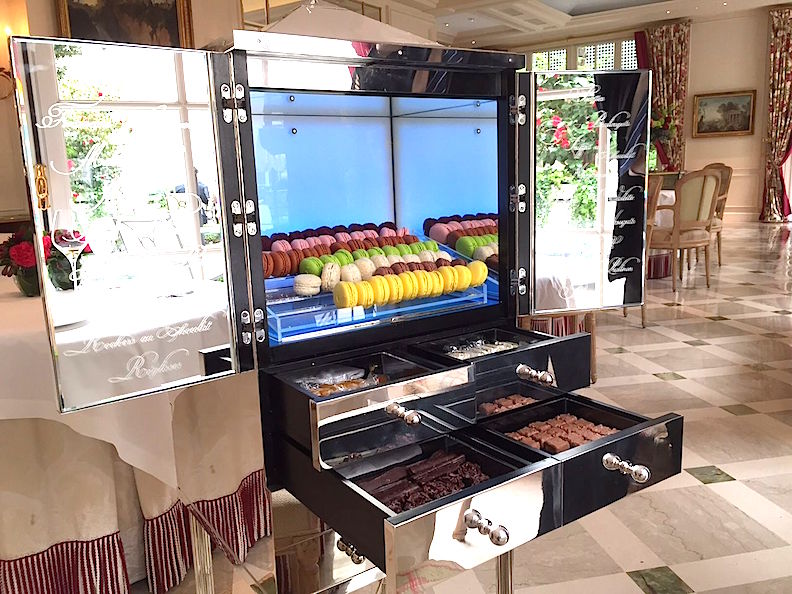 But
L’Épicure is not
just about the food. It is about all that surrounds
it, the weaving of time and delivery of a dish, the
deft spooning on of sauce, the addition of the right
bread at the right moment. It is about a master chef and
40 people in the kitchen trying twice a day to be as
flawless as possible in an enterprise fraught with
possible error, from a fish being cooked ten seconds
too long to the temperature of the dining room
ruining the texture of a sorbet. But those
errors didn’t occur that day and rarely do at a
restaurant like this.
But
L’Épicure is not
just about the food. It is about all that surrounds
it, the weaving of time and delivery of a dish, the
deft spooning on of sauce, the addition of the right
bread at the right moment. It is about a master chef and
40 people in the kitchen trying twice a day to be as
flawless as possible in an enterprise fraught with
possible error, from a fish being cooked ten seconds
too long to the temperature of the dining room
ruining the texture of a sorbet. But those
errors didn’t occur that day and rarely do at a
restaurant like this.
Add in the beauty of the room,
the sunny garden, the touch of a thick napkin and of
a tinkling thin wine glass to one’s lips, the sound
of civilized conversation, the well-dressed
clientele, and you begin to understand the unique
quality of haute dining, albeit at a very high
price. But
at L’Épicure you get everything you paid for and no
one leaves with buyer’s remorse.
Finally, although similar meals
can be had at similar restaurants in France and
other countries, this is Paris, and while you sit
spellbound by the cuisine and the service and the
loveliness of the afternoon, you are partaking of
the best this grandest of cities offers, day after
day, night after night.
L'Épicure
112 rue du Faubourg Saint-Honoré
011 +33 (0)1 53 43 43 40
Prices: Six-course
tasting menu at dinner €320 ($352), three
courses €145 ($160), with tax and service
included.
For
gentlemen, a suit jacket is required but not a tie.
By John Mariani

At
some point in the
past decade all the old dowager hotels of Paris
decided it was time to enter
the 21st century without destroying the charms
that made them so appealing in
the first place.
Goaded by the
total renovation of hotels like the Georges V
under The Four Seasons brand,
Fouquet’s Barrière and the Lutétia
and by new arrivals like the Shangri-La,
Mandarin Oriental, Peninsula, and
Park Hyatt Paris Vendôme, older hotels in the
high-end category have gotten
complete overhauls, including Le Crillon, Le
Plaza-Athenée, Le Bristol, Le
Meurice, and
The Ritz, several of
them shut down completely during renovation.
One of the landmark hotels just
now
finishing its rehabilitation is the 125-year-old Hilton Paris Opera
(left)
just
across from the Gare Saint Lazare and a few blocks
from the Opéra.
Hilton took it over last September from
Concorde Hotels and poured $50 million into its
restoration, not least the
magnificent lobby and grand hall bar area (below, left).
The hotel was originally
designed by architect
Juste Lisch for the 1899 Universal Exposition in a
Beaux Arts style;
London-based firm Richmond International has done
the restoration work. The
hotel now has 268 guest rooms and 29 suites on
five floors, and their modernity
is as fresh as a brand new hotel in San Francisco,
with light colors of gray and
pastels, very spacious, well-laid out bathrooms,
and all the finest amenities
including free WiFi, and, for the suites,
complimentary breakfast. I cannot
fail to mention that, unlike
most hotels in Europe, this one has irons and
ironing boards in the rooms. Hilton, being
an American brand, knows what American guests
expect.
My room (right)
overlooked the plaza of the Gare Saint Lazare,
from which I could watch the comings and goings of
Parisians and tourists.
The entry hall, up a few steps
to check-in and the
concierge desk, is the focal point of the hotel—a
vast room of black and gold
Corinthian columns, crystal chandeliers, wrought
iron, and gorgeously restored
mosaic floors and frescoes, all in contrast to
abstract murals ringing the bar,
“inspired” by fashion designer
Christian Lacroix.
The very
charming General Manager Sofia Vandaele is the
warm, welcoming presence of the hotel.
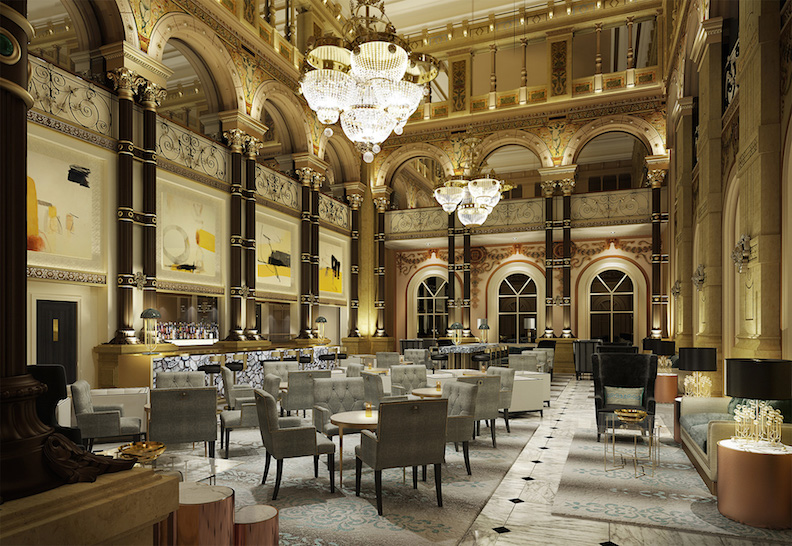 I did not have a chance
to
dine at the hotel’s Terminus Nord restaurant but
hope to report on it next time
I visit.
I did not have a chance
to
dine at the hotel’s Terminus Nord restaurant but
hope to report on it next time
I visit.
Also of note is that Hilton
encourages families to stay here through packages,
and by booking well in
advance you can get a 20 percent discount.
Not surprisingly North
American hotel companies like Hilton, Hyatt and
Four Seasons, in competition
with Hong-based Shangri-La and Mandarin-Oriental,
are driving this momentum to
upgrade and improve services in the grand old
hotels, which for a very long
time rested on laurels whose luster had worn thin.
Now I
await the re-opening of The
Ritz later
this year, which has been closed for two years and
was badly in need of
modernization (the last was done 35 years ago),
which is being overseen by
designer Thierry Déspont. Management
has
promised The Ritz’s classic elegance has in no way
been compromised, and I can’t
wait to have a bloody Mary again with bartender
Colin Field at the Hemingway Bar on premises.
TELS
❖❖❖
By John Mariani
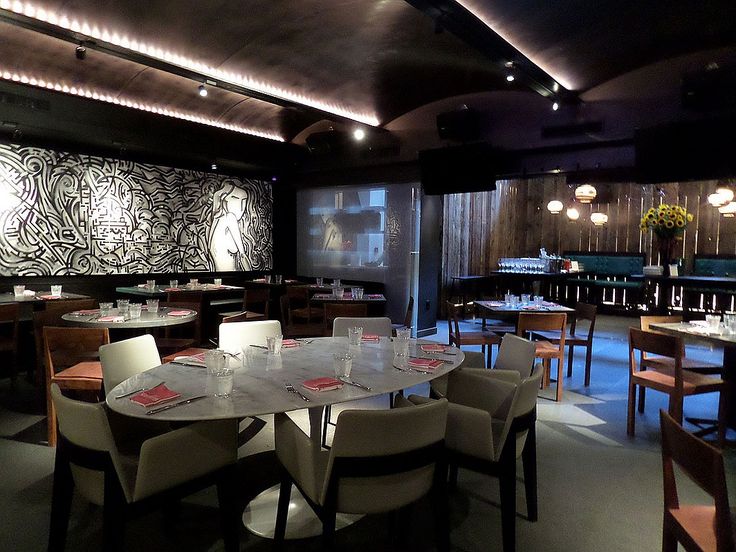 BOTEQUIM
BOTEQUIMHyatt Union Square
132 4th Avenue (at 13th Street)
212-432-1324
onefivehospitality.com/restaurants/botequim
Brazilian
restaurants outside of Brazil generally fall
into two kinds: those that serve
a narrow range of Rio-based dishes that focus on
the rich black bean and offal stew called feijoada,
and those that feature churrascaria
items, usually in a show of waiters carving
sizzling meats from a long skewer and
accompanied by ample salad bar items. The
best of the first type are found in New York's
outer boroughs, the latter in Manhattan at vast
churrascarias,
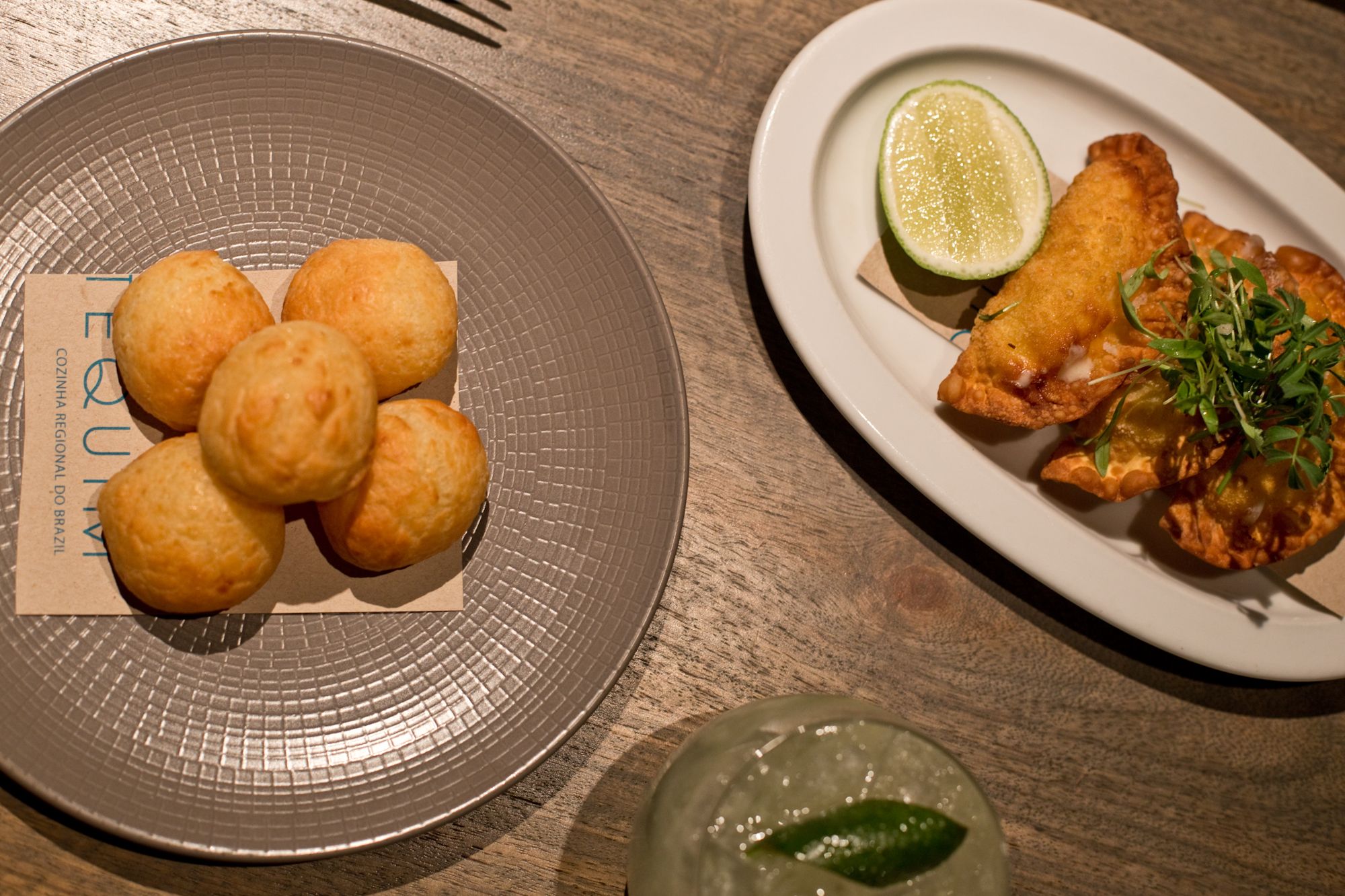 where
the cachaça flows freely.
where
the cachaça flows freely.
Botequim shares the best
aspects of both of these kinds of Brazilian
restaurants, but it brings to the table a wider
range of regional dishes done with a good deal
more care, flair and refinement than you find
elsewhere. It is also much smaller than most
Brazilian restaurants, set downstairs in a
windowless space of 100 seats composed of two
rooms, one set with three communal wooden
farmhouse tables, the other with individual
tables. The
open kitchen throws much-needed light into the
rooms, which are painted mostly in black, ceiling
included--not the most convivial color for a
subterranean restaurant--and decorated with a
graffiti-like mural by artist Marc Mazurkiewicz. Aqua
blue leather banquettes provide another splash of
much-needed color.
Early on during my mid-week
visit, the Brazilian music being piped in was of
the bombastic Techno style that in a crowded room
adds a great deal of sheer noise. I asked
a waitress if they played softer bossa nova and
samba music, and she very kindly flipped the dial
and out came the wondrous, lilting sounds
of Elis Regina, Antȏnio Carlos Jobim, Stan Getz
and Gilberto Gil, which was perfect for an
evening’s meal.
Botequim owner Marco Moreiro is
a native of São Paolo, though, with his wife and
patter Jo-Ann Makovitzky, he made his reputation
at the fine dining New York restaurant called
Toqueville. Their One Five Hospitality group also
runs the very fine 15 East, The Fourth, and a
Scotch lounge named SingL.
The best way to
appreciate Botequim is to share plates, especially
the first snack courses called salgadinhos,
which include assorted pastelzinhos,
flaky small pies filled with ground beef, cheese
or braised hearts of palm ($9). The
croquettes (above)
filled with bacalhau
(house-cured cod fish) with sliced hardboiled egg
($12) are terrific, and everyone at our table
loved the grilled Brazilian sausages called calabresa
acebolada served with sizzling onions ($11).
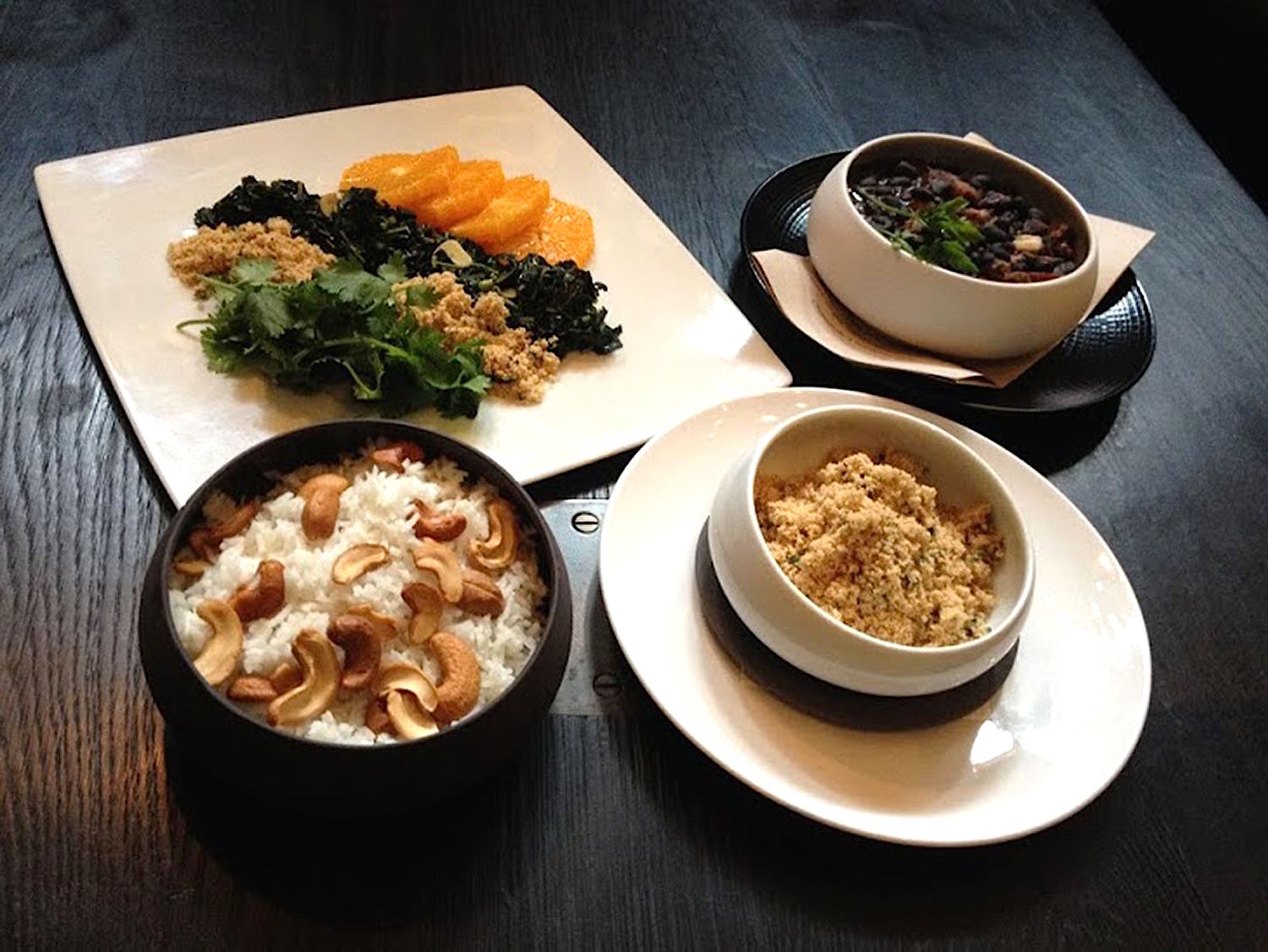 The
traditional cheesebread called pão de queijo
($7) is addictive, soft but pliable, rich with
cheese and wonderful aromas. “Grilled
Shrimp on the Beach” ($14) were plump and sweet,
and we found the salad of summer tomatoes and
hearts of palm with red wine ($15) both refreshing
and quite satisfying.
The
traditional cheesebread called pão de queijo
($7) is addictive, soft but pliable, rich with
cheese and wonderful aromas. “Grilled
Shrimp on the Beach” ($14) were plump and sweet,
and we found the salad of summer tomatoes and
hearts of palm with red wine ($15) both refreshing
and quite satisfying.
The chicken with okra and
polenta ($24) went beyond expectations because the
bird itself, from Violet Hill Farm, packed real
flavor all on its own, and the burnished roast
suckling pig with red beans and farofa made
from
manioc flour ($26) was as glorious a rendering as
I’ve had of this dish, perfectly seasoned, basted
and kept succulent beneath a crackling skin. There
is, of course, feijoada ($26)
and while I claim scant experience with the dish
on its home soil, this hearty, long-braised stew
was better at Botequim than any I remember in Rio
de Janeiro, rich with collards, farofa,
cashews, and a rice and orange salad (left).
The beef options, not
carried around on skewers, include picanha ($34),
a prime cut of superb top sirloin (below)
roasted on the hearth with garlic and oil, and costela
($28)--easily one of the most delicious short ribs
dishes I’ve ever encountered in a city blanketed
with them these days. The prices are exceptionally
reasonable.
We took some home.
Delicacy is not a word that
leaps to mind when it comes to overly sweet
Brazilian desserts, but at Botequim the emphasis
is on the fruit flavors and the acid they provide,
starting with the excellent sorbets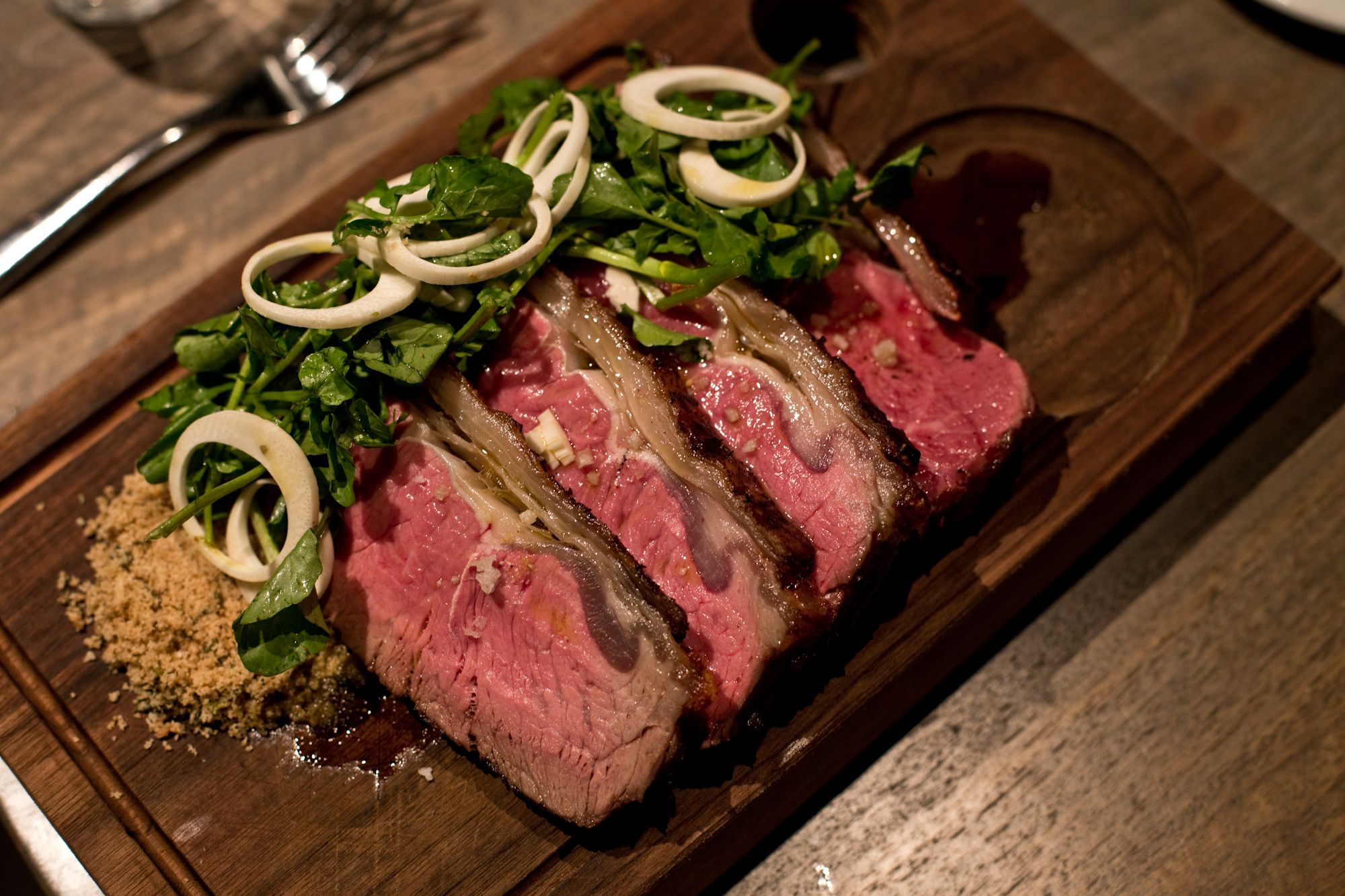 and ice creams at
just the right textures ($9); rice
pudding with coconut tapioca ($10); an
irresistible coconut cake with pineapple cachaça
sorbet ($12); and sonhos
(“dreams”), a fried dough traditional at
Christmas, here with doce de leite,
chocolate and guava ($10).
and ice creams at
just the right textures ($9); rice
pudding with coconut tapioca ($10); an
irresistible coconut cake with pineapple cachaça
sorbet ($12); and sonhos
(“dreams”), a fried dough traditional at
Christmas, here with doce de leite,
chocolate and guava ($10).
Master Sommelier Roger
Dagorn oversees all the company’s wine lists, and
the bottlings on Botequim’s list offer examples of
some of the best reds coming out of South America
right now. He
is also in charge of the cocktails program, and I
urge you to try any of the caipirinhas, which go
very well with the appetizers here.
I hesitate to comment on the
overall service at Botequim on the basis of one
fairly slow night--restaurants almost always have
better service on busy nights--but, although the
staff was well meaning and friendly, they weren’t
often in the dining room that evening, and some
dishes were slow to come out of the kitchen.
Botequim proves that while the
flavors of gutsy Brazilian food have their obvious
appeal, it is the re-thinking and improvement on
traditional regional dishes that makes an
extraordinary difference in the quality of the
food here. Botequim
is a little treasure in Manhattan.
Open Tues.-Sat for dinner. Brunch
on Saturday.
❖❖❖
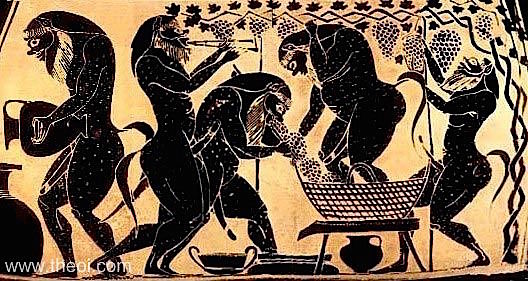
GREEK WINES FIRMLY IN
THE 21ST CENTURY. . . A.D.
By Mort Hochstein
Winston
Churchill,
speaking of France, once remarked: “How
can anyone govern a country that has 246
cheeses.” Greece raises more than 200 grape
varieties and, although this has little to do
with politics or that nation’s troubled
finances, the unlikely comparison somehow
arises. But Greek producers are doing their
utmost to contribute to financial recovery.
While they lay claim to being the
birthplace of the European wine industry, the
Greeks were never a match for the French or the
Italians for selling wine outside of their
Mediterranean trading region. A
number of years ago I attended a tasting of wines
at a Greek restaurant in Manhattan. The
food was wonderful, but there were problems on the
wine side. It seemed as if the exhibitors felt
their only market was among fellow Greeks, and
they made no attempt to bridge the language gap.
It was definitely all Greek to me and there was no
profit in that.
The labels were all in the native language,
as was the limited amount of literature available,
and there were no friendly translators. If it
hadn’t been for the baklava, spinach pie and
moussaka and other assorted Hellenic goodies, the
afternoon would have been a total loss. 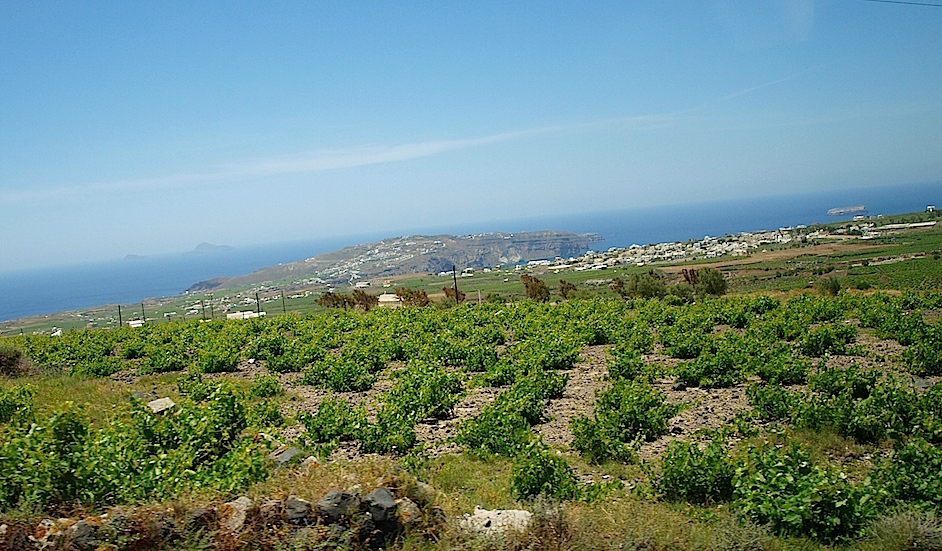
But that was long ago and now the Greeks
have learned Marketing 2.0. Wines designated for
English-speaking markets have proper labels, come
with ample explanatory literature and tastings are
conducted in English. True, the wine names, such
as Mavrotragano,
Assyrtiko and Xinomavro can be tongue
twisters, but they are rapidly becoming more
familiar.
Assyrtiko, for one, could easily move into
the category of world-class whites. It
is like Chardonnay, a widely grown workhorse grape
that takes on many variations, depending on its
place of origin and the aspirations of the
winemaker. It
flourishes on Santorini, one of the most popular
Greek islands for visitors. Indeed, the very
popularity of that island threatens to cut into
availability as more and more of the land is being
given over to tourism.
At
Santorini (right),
the Assyrtiko vines tremble atop wind-raked
heights on a sleeping volcano. Assyrtiko wines are
powerful and intense, exuding lemon and mineral
scents. And they are blessed with the ability to
remain potent
for a decade or more.
In New York
recently we enjoyed Assyrtiko whites from Sigalas, Hatzidakis and Gaia (below), three of the most highly
regarded producers on that rugged island. They had great
minerality, good acidity, and proper balance and
were commendable examples of a grape I am learning
to like. Sigalas
also produces a dry white from another native
grape, Aidani, a much less assertive varietal,
enjoyed for its soft blend of flowers and herbs on
the palate and a lesser degree of minerality and
acidity than its Assyrtiko siblings.
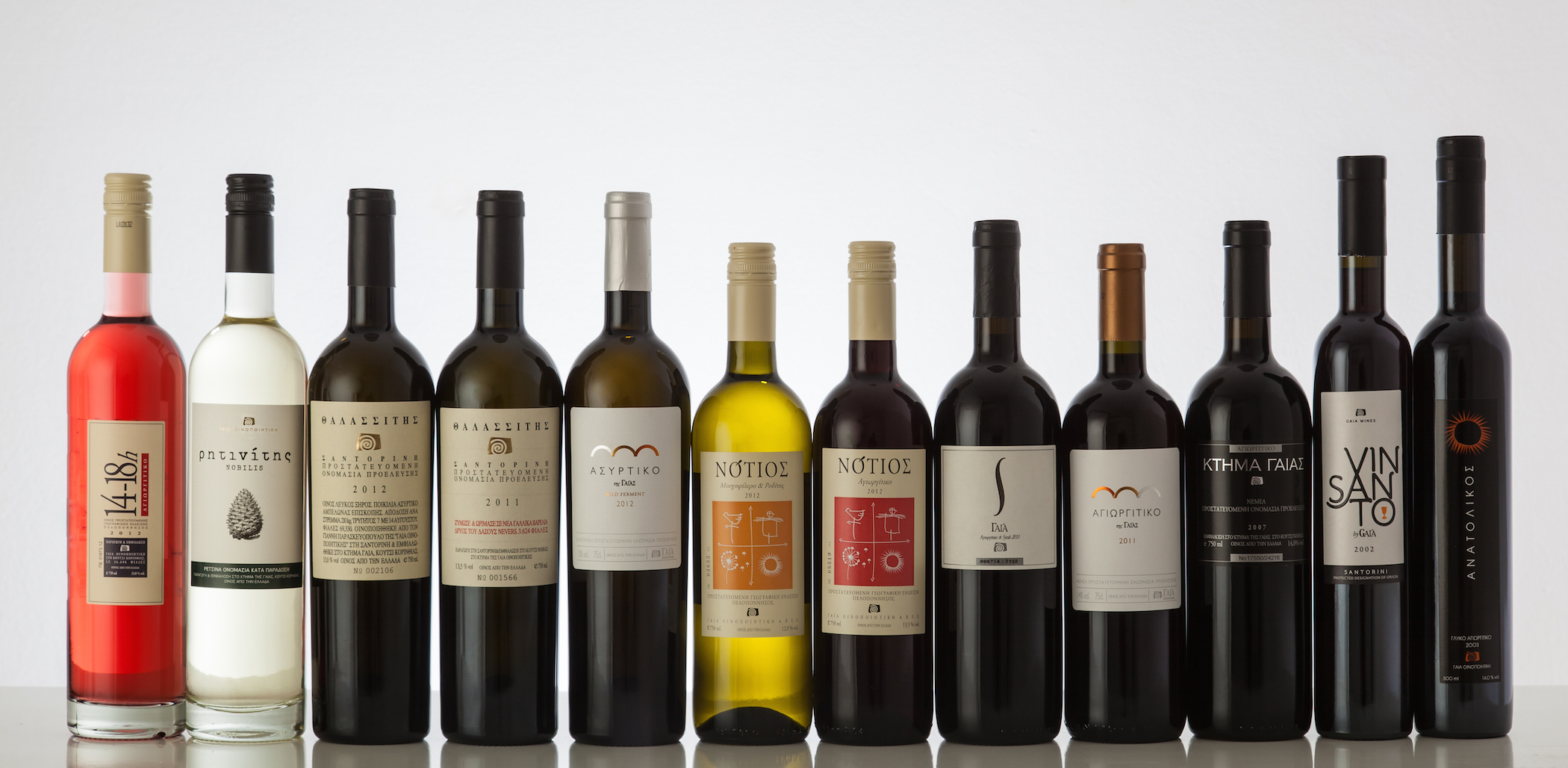 I’ve often come away from
Italian Vin Santo feeling I missed something in
that dessert wine. But Gaia’s 2004
Vin Santo, based on Assyrtiko and two other
native grapes, Athini and Aidani, was a
revelation. The wine was minimally sweet, full
bodied and hardly cloying. It did not disappoint. It is a
wine that adds power with time. The
Gaia Vin Santo stays a minimum of eight years in
barrels before being released.
I’ve often come away from
Italian Vin Santo feeling I missed something in
that dessert wine. But Gaia’s 2004
Vin Santo, based on Assyrtiko and two other
native grapes, Athini and Aidani, was a
revelation. The wine was minimally sweet, full
bodied and hardly cloying. It did not disappoint. It is a
wine that adds power with time. The
Gaia Vin Santo stays a minimum of eight years in
barrels before being released.
There’s a Greek
red that bears an uncanny resemblance to the great
wines of the Piedmont, Barolo and Barbaresco, and
at a much lesser price. The Xinomavro grapes
originate in Naoussa, neighboring on Macedonia,
and the wine they yield is definitely worth
seeking out. Brands I can recommend are Kir-Yianni,
which produces Xinomavro, Syrah, Merlot and
Cabernet Sauvignon as well as Assyrtiko and
assorted whites; Domaine Kaydas, which makes just
one wine, an old school, robust Xinomavro; and
Thymopoulos Urano, which takes the opposite tack
to appeal to contemporary tastes, using more oak,
and showing the vanilla and spice you might find
in a far more expensive Barolo. 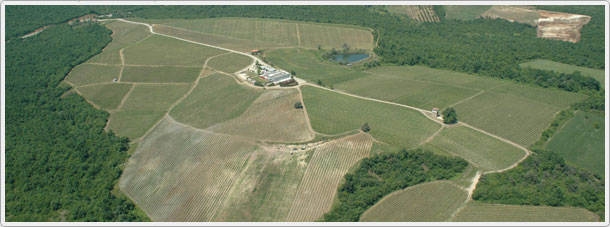
A bit to the west of the Naoussa (right)
vineyard are Florina and Amyndeon, two regions
also producing noteworthy Xinomavro. The latter
vineyard extends over 1,700 acres on a
half-mile-high
plateau in the midst of three large
mountains and two lakes; it is the smallest,
coldest and driest vineyard in Greece. Xinomavro
from Florina and Amyndeon arrives in several
forms, from dry to sparkling, but primarily in big
reds with protracted aging capacity. Given
one choice, I would go for Xinomavro
Reserve Old Vines from Alpha
Estate, its grapes blossoming on ungrafted
vines a little under a century
old. It is a full-bodied stunner, rich in
blackberries and plums on the palate,
strawberries, dark cherries and spices on the
nose, and a long aftertaste.
As they struggle to
improve their product, bring production methods
into the 21st century and learn from the
experience of producers in other nations, the
Greeks are developing their marketing chops.
❖❖❖

NOTHING LIKE A NICE
SMOKE BATH BETWEEN
BOMBINGS
“In the
isolated Nuba Mountains on the southern border of
Sudan, the air is unpolluted—there’s no electricity,
and most people don’t have cars—but the atmosphere
is always charged.
Since 2011, there has been fighting between
the rebels in the region and the ruling regime in
Khartoum, the nation’s capital. People
keep watchful eyes and ears turned towards the ski
in anticipation of the next bombing (the Sudanese
air force has dropped 3.500 bombs on civilian
targets). But
amid this ugly conflict, I've found beauty: A woman
named Sarah Juma has invited me to join her dukham, a
traditional smoke bath that refreshes and
revitalizes the skin.”—Amanda Sperber, “Some
Signals,” Marie-Claire
(July, 2015).
IT GOES GREAT
WITH. . . NOTHING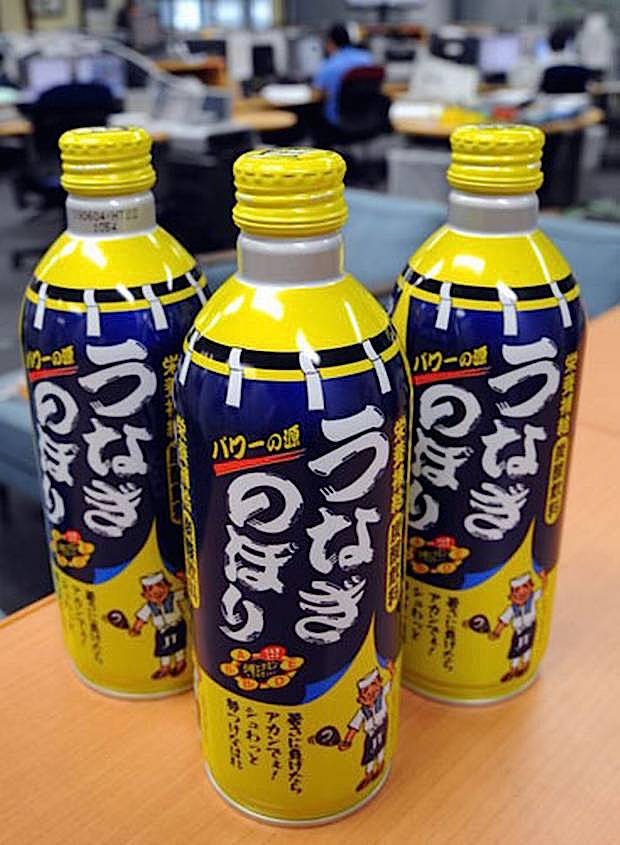
Kimura Inryou, a beverage company based in
Shizuoka Prefecture, Japan, is producing an
eel-flavored soda, “flavored with eel extract.”
Any of John Mariani's books below may be ordered from amazon.com.
 I'm proud and happy to announce that my
new book, The Hound
in Heaven (21st Century Lion Books), has just
been published through Amazon and Kindle.
I'm proud and happy to announce that my
new book, The Hound
in Heaven (21st Century Lion Books), has just
been published through Amazon and Kindle. It is a novella, and for anyone who loves dogs, Christmas, romance, inspiration, even the supernatural, I hope you'll find this to be a treasured favorite. The story concerns how, after a New England teacher, his wife and their two daughters adopt a stray puppy found in their barn in northern Maine, their lives seem full of promise. But when tragedy strikes, their wonderful dog Lazarus and the spirit of Christmas are the only things that may bring back his master back from the edge of despair.
WATCH THE VIDEO!
“What a huge surprise turn this story took! I was completely stunned! I truly enjoyed this book and its message.” – Actress Ali MacGraw
“He had me at Page One. The amount of heart, human insight, soul searching, and deft literary strength that John Mariani pours into this airtight novella is vertigo-inducing. Perhaps ‘wow’ would be the best comment.” – James Dalessandro, author of Bohemian Heart and 1906.
“John Mariani’s Hound in Heaven starts with a well-painted portrayal of an American family, along with the requisite dog. A surprise event flips the action of the novel and captures us for a voyage leading to a hopeful and heart-warming message. A page turning, one sitting read, it’s the perfect antidote for the winter and promotion of holiday celebration.” – Ann Pearlman, author of The Christmas Cookie Club and A Gift for my Sister.
“John Mariani’s concise, achingly beautiful novella pulls a literary rabbit out of a hat – a mash-up of the cosmic and the intimate, the tragic and the heart-warming – a Christmas tale for all ages, and all faiths. Read it to your children, read it to yourself… but read it. Early and often. Highly recommended.” – Jay Bonansinga, New York Times bestselling author of Pinkerton’s War, The Sinking of The Eastland, and The Walking Dead: The Road To Woodbury.
“Amazing things happen when you open your heart to an animal. The Hound in Heaven delivers a powerful story of healing that is forged in the spiritual relationship between a man and his best friend. The book brings a message of hope that can enrich our images of family, love, and loss.” – Dr. Barbara Royal, author of The Royal Treatment.
 |
The Encyclopedia of American Food and Drink by John F. Mariani (Bloomsbury USA, $35) Modesty forbids me to praise my own new book, but let me proudly say that it is an extensive revision of the 4th edition that appeared more than a decade ago, before locavores, molecular cuisine, modernist cuisine, the Food Network and so much more, now included. Word origins have been completely updated, as have per capita consumption and production stats. Most important, for the first time since publication in the 1980s, the book includes more than 100 biographies of Americans who have changed the way we cook, eat and drink -- from Fannie Farmer and Julia Child to Robert Mondavi and Thomas Keller. "This book is amazing! It has entries for everything from `abalone' to `zwieback,' plus more than 500 recipes for classic American dishes and drinks."--Devra First, The Boston Globe. "Much needed in any kitchen library."--Bon Appetit. |
"Eating Italian will never be the same after reading John Mariani's entertaining and savory gastronomical history of the cuisine of Italy and how it won over appetites worldwide. . . . This book is such a tasteful narrative that it will literally make you hungry for Italian food and arouse your appetite for gastronomical history."--Don Oldenburg, USA Today. "Italian
restaurants--some good, some glitzy--far
outnumber their French rivals. Many of
these establishments are zestfully described
in How Italian Food Conquered the World, an
entertaining and fact-filled chronicle by
food-and-wine correspondent John F.
Mariani."--Aram Bakshian Jr., Wall Street
Journal.
"Equal parts
history, sociology, gastronomy, and just
plain fun, How Italian Food Conquered the
World tells the captivating and delicious
story of the (let's face it) everybody's
favorite cuisine with clarity, verve and
more than one surprise."--Colman Andrews,
editorial director of The Daily
Meal.com. "A fantastic and fascinating
read, covering everything from the influence
of Venice's spice trade to the impact of
Italian immigrants in America and the
evolution of alta cucina. This book will
serve as a terrific resource to anyone
interested in the real story of Italian
food."--Mary Ann Esposito, host of PBS-TV's
Ciao
Italia. "John Mariani has written the
definitive history of how Italians won their
way into our hearts, minds, and
stomachs. It's a story of pleasure over
pomp and taste over technique."--Danny Meyer,
owner of NYC restaurants Union Square
Cafe, The Modern, and Maialino.
|
 |
 |
 |
 |
 |
 |
 |
 |
 Everett Potter's Travel Report:
Everett Potter's Travel Report: 
 Eating Las
Vegas is the new on-line site for
Virtual Gourmet contributor John A. Curtas.,
who since 1995 has been commenting on the
Las Vegas food scene and reviewing
restaurants for Nevada Public Radio.
He is also the restaurant critic for KLAS
TV, Channel 8 in Las Vegas, and his past
reviews can be accessed at KNPR.org.
Click on the logo below to go directly to
his site.
Eating Las
Vegas is the new on-line site for
Virtual Gourmet contributor John A. Curtas.,
who since 1995 has been commenting on the
Las Vegas food scene and reviewing
restaurants for Nevada Public Radio.
He is also the restaurant critic for KLAS
TV, Channel 8 in Las Vegas, and his past
reviews can be accessed at KNPR.org.
Click on the logo below to go directly to
his site.

Tennis Resorts Online: A Critical Guide to the World's Best Tennis Resorts and Tennis Camps, published by ROGER COX, who has spent more than two decades writing about tennis travel, including a 17-year stretch for Tennis magazine. He has also written for Arthur Frommer's Budget Travel, New York Magazine, Travel & Leisure, Esquire, Money, USTA Magazine, Men's Journal, and The Robb Report. He has authored two books-The World's Best Tennis Vacations (Stephen Greene Press/Viking Penguin, 1990) and The Best Places to Stay in the Rockies (Houghton Mifflin, 1992 & 1994), and the Melbourne (Australia) chapter to the Wall Street Journal Business Guide to Cities of the Pacific Rim (Fodor's Travel Guides, 1991).


MARIANI'S VIRTUAL GOURMET
NEWSLETTER is published weekly. Editor/Publisher: John
Mariani.
Editor: Walter Bagley. Contributing Writers: Christopher Mariani,
Robert Mariani, Misha
Mariani,
John A. Curtas, Edward Brivio, Mort Hochstein,
Andrew Chalk, Dotty Griffith and Brian Freedman. Contributing
Photographers: Galina Dargery, Bobby
Pirillo. Technical Advisor: Gerry McLoughlin.
To un-subscribe from this newsletter,click here.
© copyright John Mariani 2015

